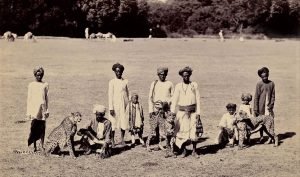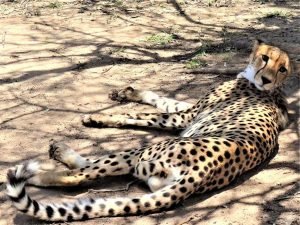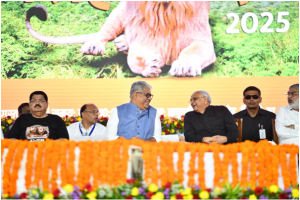
BY DR. RAVINDER PALL SAINI
INDIAN FOREST SERVICE ( RETIRED)
MEMBER, BOARD OF ADMINISTRATION,
FOREST RESEARCH UNIVERSITY,
DEHRADUN
DEHRADUN, 5 APRIL 2023:
India has welcomed the birth of four cheetah cubs – more than 70 years after the animals were declared officially extinct in 1952. A historic moment indeed.
The foursome was born to Siyaya and Freddie in Madhya Pradesh's Kuno National Park on 24 th March 2023. Siyaya means ‘moving forward’ — who knew when they named her that a cheetah found at a wild waterhole in Namibia would lead the way in one of the most ambitious wildlife revival missions in the world.
History:
In 1947, the last known Asiatic cheetah was shot by Maharaja Ramanuj Pratap Singh Deo from the princely state of Koriya in what is today known as Chhattisgarh. By 1952, the species was declared extinct in India. Now, almost 70 years later, the animal will be reintroduced into the country through its African counterparts, Namibia and South Africa.

This is the only known photograph of live Indian cheetah; Photo: © Samarjitsinh Gaekwad of Baroda the
hunting cheetah of Maharaja Sayajirao, Baroda in 1890. This is the only known photograph of live Indian cheetah; Photo: © Samarjitsinh Gaekwad of Baroda
Findings show that about 200 cheetahs were killed in India, largely by sheep and goat herders, during the colonist period. Some of them were eliminated through prize hunting because of Man – Animal conflict affecting the villagers. The cheetah is the only large mammal to become extinct in the country since its independence from British rule.

Sadly, this beautiful animal is threatened by loss of habitat and prey, as well as conflict
with humans. As a result, the cheetah is classified as Vulnerable on the IUCN Red list, and, today, an estimated 9,000-12,000 remain in Africa. The first cheetah in the world to be bred in captivity was in India during the rule of Mughal emperor Jahangir. His father, Akbar, recorded that there were 10,000 cheetahs during his time. He reigned from 1556 to 1605.

Much later, research suggested the number of cheetahs had dropped to a couple of hundred by the 19th Century – and the cat was reportedly sighted for the last time in India 70 years ago.India has been making efforts to reintroduce cheetahs since the 1950s. An effort in the 1970s from Iran was unsuccessful after the Shah of Iran was deposed and the negotiations stopped.
The Relocation Efforts:
The country has been trying to reintroduce the big cats for decades, and last year on 17 th September, Hon’ble PM of India released the eight cheetahs, five females and three males brought over from Namibia as part of the intercontinental translocation plan at Kuno National Park in special enclosures known as Boma for quarantine. An additional batch of 12 cheetahs were brought to India from South Africa last month.
Although the plan was ready in India way back in 2012 but was put on hold by the Supreme Court in 2013 on plea by some conservationists. On pursuance by Government with a Cheetah release cum conservation plan after a good research and groundwork the Supreme Court allowed the plan in 2020. Today the efforts take shape.
I had the opportunity to visit South Africa, Kruger National Park in 2017 and studied Cheetahs both in wild as well at the breeding centers there. Hope the planned reintroduction goes well at Kuno National Park, in Madhya Pradesh.

The dedicated efforts of Forest & Environment Ministry, Madhya Pradesh Government, Wildlife Institute of India and all their concerned dedicated Officers deserve salutations for this initial success. Hope all goes well for future conservation strategy too.
CHRONOLOGY OF 50 YEARS CHEETAH COMING BACK DREAM:
- In 1970s first efforts were made by Government of India with Iran to exchange Asiatic cheetahs with our Asiatic Lions, but it could not be materialized and eventually Cheetah got extinct in Iran too.
- During 2009 to 2012 again efforts were initiated by the Ministry of Forests and Environment with help of Wildlife Institute of India and several sites in Madhya Pradesh, Rajasthan, Chhattisgarh, and Uttar Pradesh were surveyed but Supreme Court banned the project on pleas that it was not properly conceived, and National Wildlife Board not consulted.
- In 2020 the ban was lifted when the Government approached with completion of all necessary formalities and strategies with the help of concerned agencies. National Tiger Conservation Authority with help of Wildlife Institute of India formulated the plan and strategy. The committee of experts selected Kuno National Park in Madhya Pradesh as the initial site for reintroduction of Cheetah. A memorandum of understanding was worked out with Namibia and South Africa for bringing in wild cheetahs in phases as per conservation plan and strategy devised by experts in this regard.

NOTABLE FACTS ABOUT CHEETAH:
The Cheetah (Acinonyx jubatus) is a large Feline (family Felidae, subfamily Felinae) inhabiting most of Africa and parts of the Middle East. It is the only extant member of the genus Acinonyx.
Nearly all wild cheetahs can be found in sub-Saharan Africa, where they roam open, grassy savannah plains and open forests. These big cats’ bodies grow to between 1.1m and 1.4m meters long, plus a tail measuring 65cm to 80cm. Their weight ranges from 34kg to 54kg, males being slightly heavier.
Cheetahs have a pale-yellow coat with black dots on the upper parts and are white on the underbelly. Their faces are distinguished by prominent, black lines that curve from the inner corner of each eye to the outer corners of the mouth.
The fastest land animal in the world, a cheetah can reach 112km/h in just three seconds – that’s faster than a sports car accelerates! Its body has evolved for speed, with long legs, an elongated spine, adapted claws to grip the ground and a long tail for balance.
Cheetahs are carnivores and live off other animals they find on Africa’s plains, including rabbits, warthogs, springboks, gazelles, and birds.

These fierce felines hunt during the day to avoid competition from other powerful predators such as lions, hyenas, and leopards. And boy, can they hunt! First, they use their exceptional eyesight to scan their surroundings before quietly stalking their chosen prey. Then, when the time is right, they sprint from cover, knock down their victim and kill it with a bite to the throat.
As sprinting at such mega speeds uses a lot of energy, a cheetah chase is usually limited to 200-300m and lasts less than a minute.
Social animals, cheetahs are usually found in groups, consisting of either a mother or her young, siblings (who stay together for around six months after leaving the mother) or a coalition of males who live and hunt together. Adult females, however, tend to be solitary and only meet with males to mate. Females usually give birth to between two to eight cubs at a time. She nurses her youngsters in a lair hidden by tall vegetation, until they are 16 to 24 months old and able look after themselves.
Classified as a vulnerable species under the International Union for Conservation of Nature (IUCN) Red List of Threatened Species, only around 7,000 are left in the wild worldwide.
Officials announced the agreement after spending the past two years working on how to transport the animals after India’s supreme court decided in 2020 that they could be reintroduced in a “carefully chosen location”. Despite the animal’s lightning-quick speeds, a combination of hunting, habitat loss and food scarcity led to the cheetah’s disappearance in India. It is the only large mammal to become extinct in the country since its independence from British rule.
The Asiatic Cheetah could once be found in areas stretching from the Arabian Peninsula to Afghanistan.
Efforts have been made to revive India’s cheetah numbers since the 1950s. An attempt to bring them from Iran in the 1970s – when Iran had around 300 of the animals – failed after negotiations ended when the Shah was deposed in the Iranian Revolution. Indian officials are keen for this most recent attempt to succeed long term.

What are the challenges the cheetahs might face?
Leopards, for one. They can limit the population by killing cheetah cubs, especially in the Kuno national park. Cheetahs are delicate animals, meant for speed. They avoid conflict and are targeted by competing predators.
The cheetahs coming to India have been exposed to lions, leopards, hyenas, and wild dogs at home. In Kuno, they will have their first encounters with sloth bears, striped hyenas, and wolves. Their main prey base in India will be spotted and large deer and the Indian gazelle, and the four-horned antelope.
“So, we believe that they are experienced enough to handle any dangerous interactions with the leopards in Kuno,” says Mr. Van der Merwe.

Also, in unfenced reserves like Kuno there is also a possibility that the cheetahs can disperse in any direction and become isolated. This will be managed by either satellite or VHF tracking collars to bring them back to the central area.

“The cheetahs do seem to settle down after a while and we have strategies in place to keep the males, in particular, anchored to the initial release site using scent markings etc,” says Prof Tordiffe.
Relocation of animals is always fraught with risks.
“We are taking animals out of a familiar environment, and it takes time for them to really feel comfortable in their new habitat. It is true that cheetahs are known to have lower survival rates after reintroductions than other large carnivores,” says Prof Tordiffe.
But he points out to a well-documented reintroduction of cheetahs in Malawi where 80% of the adult cheetahs were still alive after a year and that their population managed to grow quite successfully despite the loss of 20% of the cats in the first year.
How does India plan to sustain a cheetah population?
Some Indian conservationists remain skeptical of the idea, saying that most of the country’s former cheetah habitats are shrinking because of pressure on land.
Officials are more optimistic and believe Kuno park has sufficient space, ample prey and less pressure of human population, all key to the cheetah’s survival.India is looking at a capacity population of 20 cheetahs in Kuno national park.

In five to six years, the country plans to import and locate 50 to 60 cheetahs in half-a- dozen reserves and parks across the country and move the animals around for genetic and demographic diversity.
Why is this a globally important project?
Experts say this is a key experiment in conservation of the cheetah. There are only about 12 Asiatic cheetahs left in the wild in Iran. A recent genetic survey revealed that these animals are highly inbred.
“It is, in my view, ridiculous to have any hope of reviving that little isolated population from such a small base. Trying to conserve subspecies like that is a waste of effort and has little chance of success. It is better to focus on the global population even if that means allowing some level of hybridization,” says Prof Tordiffe.
The cheetah reintroduction into India is a bold step in terms of conservation and one that is desperately needed if we are to have any chance of saving this species from extinction.

Advertisement:






























Add Comment